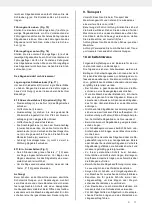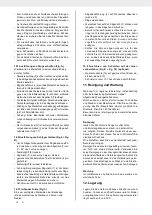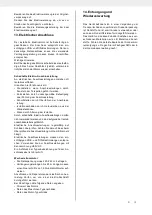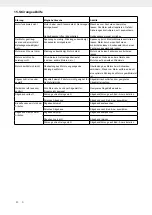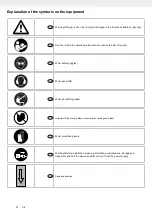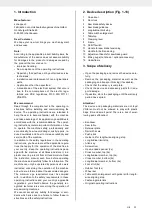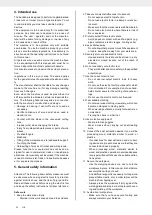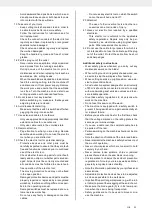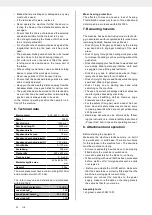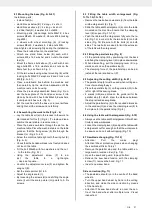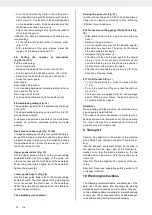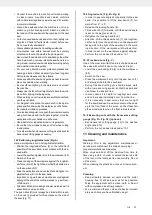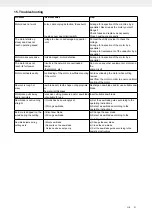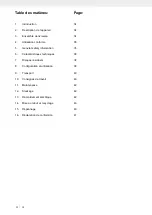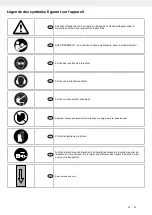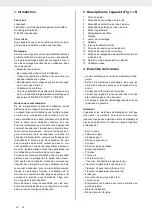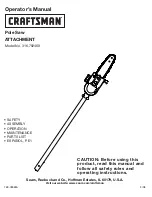
29
GB
• Connect the machine to a suction unit when working
in closed rooms. A suction device which conforms
with commercial regulations must be used for suction
in commercial areas.
• Loosen the sawband when the machine is not in op-
eration (e.g. after finishing work). Attach a notice on
the tension of the saw band to the machine for the next
user.
• Collect unused sawbands and store them safely in a
dry place. Check for faults (teeth, cracks) before use.
Do not use faulty sawbands!
• Wear suitable gloves when handling sawbands.
• All protective and safety devices must be securely
mounted on the machine before beginning work.
• Never clean the sawband or the sawband guide with a
hand-held brush or scraper while the sawband is run-
ning. Resin-covered sawbands impair working safety
and must be cleaned regularly.
• For your own protection, wear protective glasses and
hearing protection. Wear a hairnet if you have long hair.
Roll up loose sleeves over the elbows.
• Always position the sawband guide as near the work-
piece as possible when working.
•
Insure sufficient lighting in the work area and around
the machine.
• Always use the fence for straight cuts to keep the work-
piece from tipping or slipping away.
• When working on narrow workpieces with manual feed,
use the push stick.
• For diagonal cuts, place the saw bench in the appro-
priate position and guide the workpiece on the fence.
• Insure safe workpiece guidance.
• For arced and irregular cuts, push the workpiece evenly
using both hands with the fingers together. Hold the
workpiece with your hands on a safe area.
• Use a pattern for repeated arced or irregular cuts.
• Insure that the workpiece does not roll when cutting
round pieces.
• For safe work when transverse cutting, use the special
transverse cutting gauge accessory.
10.1 Performing longitudinal cuts (Fig. A)
Here, a workpiece is cut in its longitudinal direction.
• Position the longitudinal fence (5) on the left side (if
possible) of the saw band, in accordance with the de-
sired width.
• Lower the saw band guide (4) onto the workpiece. (8.9)
• Switch on the saw.
• Press one edge of the workpiece against the longitudi-
nal fence (5) with the right hand, whilst the flat side lies
on the saw bench (7).
• Slide the workpiece at an even feed rate along the lon-
gitudinal fence (5) into the saw band.
•
Important: Long workpieces must be secured against
tipping at the end of the cutting process (e.g. with reel-
off stand, etc.)
• Attention! When processing narrower workpieces it is
essential to use a push stick.
The push stick (R) must always be stored within reach,
on the hook (j) provided for this purpose on the side of
the saw (Fig. 17).
10.2 Angled cuts (Fig. B+ Fig. 6)
• In order to execute angled cuts parallel to the saw
band, it is possible to tilt the saw bench (7) for-
wards from 0° - 45°.
• Release the locking handle (E).
• Tilt saw bench (7) forwards, until the desired angle
is set on the degree scale (I).
• Retighten the locking handle (E).
•
Attention: With a tilted saw bench (7), the longitudi
-
nal fence (5) must be positioned on the downward
facing side to the right of the saw band in the work-
ing direction (if the workpiece width allows this),
in order to secure the workpiece against slipping.
• Perform the cut as described under 10.1.
10.3 Freehand cuts (Fig. C)
One of the most important features of a band saw is
the ease with which it can cut curves and radii.
• Lower the saw band guide (4) onto the workpiece.
(8.9)
• Switch on the saw.
•
Press the workpiece firmly onto the saw bench (7)
and slowly slide into the saw band.
• During freehand cutting you should always work
with a low advancing speed, so that the saw band
can follow the desired line.
• In many cases it is helpful to roughly saw curves
and corners approximately 6 mm from the line.
• If it is necessary to saw curves that are too tight
for the saw band used, auxiliary cuts must be sawn
up to the front face of the curve, so that these fall
off as wood waste when the final radius is sawn.
10.4 Executing cuts with the transverse cutting
gauge (Fig. D + Fig. 18) (optional)
• Set transverse cutting gauge (14) to the desired
angle (see 8.10)
• Perform the cut as described under 10.1.
11. Cleaning and maintenance
Important.
Warning! Prior to any adjustment, maintenance or
service work disconnect the mains power plug!
General maintenance measures
Wipe chips and dust off the machine from time to
time using a cloth. In order to extend the service life
of the tool, oil the rotary parts once monthly. Do not
oil the motor.
When cleaning the plastic do not use corrosive prod -
uct.
Cleaning
• Keep all safety devices, air vents and the motor
housing free of dirt and dust as far as possible.
Wipe the equipment with a clean cloth or blow it
with compressed air at low pressure.
• We recommend that you clean the device immedi-
ately each time you have finished using it.
Summary of Contents for HBS300XWB
Page 4: ...Fig 7 2 8 Fig 4 2 c E Fig 5 E Fig 5 1 Fig 6 F E G H H I Fig 7 Fig 7 1 Fig 7 3 d d 6 6 ...
Page 5: ...Fig 9 1 Fig 9 1 Fig 10 Fig 8 1 Q L M O k Fig 9 8 Fig 7 4 d Fig 8 k P 5 ...
Page 7: ...Fig 16 h h e i i Fig 17 R j e e Fig 18 n k l 14 o m ...
Page 8: ...DE 9 20 GB 21 31 FR 32 43 Fig A Fig B Fig D Fig C ...
Page 44: ...R1 R2 K2 K2 K1 230V C ...
Page 45: ...45 94 149 194 ...
Page 46: ...46 ...



